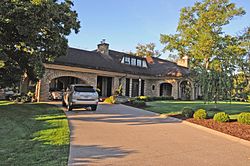
Huntington is a city in Cabell and Wayne counties in the U.S. state of West Virginia. The county seat of Cabell County, the city is located at the confluence of the Ohio and Guyandotte rivers. Huntington is the second-most populous city in West Virginia, with a population of 46,842 as of the 2020 census. Its metro area, the Huntington–Ashland metropolitan area, is the largest in West Virginia, spanning seven counties across three states and having a population of 376,155 at the 2020 census.

The Clover site (46CB40) is a Fort Ancient culture archeological site located near Lesage in Cabell County, West Virginia, United States. It is significant for its well-preserved remains of a late prehistoric/protohistoric Native American village. The site's unique assemblage has made it the type site for the Clover Phase of the Madisonville horizon of the Fort Ancient culture.
Guyandotte is a historic neighborhood in the city of Huntington, West Virginia, that previously existed as a separate town before annexation was completed by the latter. The neighborhood is home to many historic properties, and was first settled by natives of France at the end of the eighteenth century. Guyandotte was already a thriving town when the state of West Virginia was formed from part of Virginia. Located at the confluence of the Guyandotte River and the Ohio River, it was already a regional trade center with several industries of its own when the Chesapeake and Ohio Railway (C&O) reached its western terminus nearby just across the Guyandotte River in 1873. This event was soon followed by the formation and quick development of the present city of Huntington which was named in honor of the C&O Railway's founder and then principal owner Collis P. Huntington.

This is a list of the National Register of Historic Places listings in Cabell County, West Virginia.
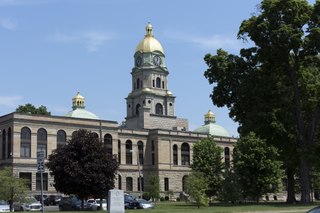
The Cabell County Courthouse in Huntington, West Virginia was built in the Beaux-Arts Classical style in 1899. Originally designed by Gunn and Curtis of Kansas City, and has been expanded in several phases. The construction of the courthouse was supervised by local Huntington architect James B. Stewart.

The United States Post Office and Court House in Huntington, West Virginia is a federal building housing the United States District Court for the Southern District of West Virginia. It was built in 1907 and expanded in 1907, and again in 1937. The original construction was the result of the Tarsney Act of 1893. The federal courthouse is part of a group of significant civic structures in the center of Huntington that includes the Cabell County Courthouse, the Huntington City Hall and the Carnegie Public Library. The original design was by Parker and Thomas of Boston and Baltimore. The post office has since been moved to another location. In 1980, the United States Congress passed legislation renaming the building the Sidney L. Christie Federal Building, in honor of District Court judge Sidney Lee Christie.
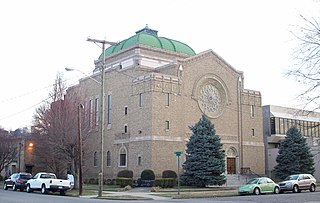
Ohev Sholom Temple, now known as B'Nai Sholom Congregation, is a historic synagogue located at 949 10th Avenue, in Huntington, Cabell County, West Virginia, in the United States.
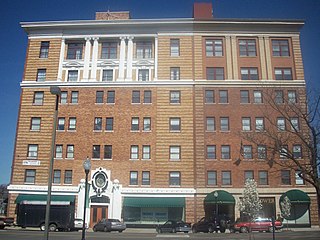
The Masonic Temple—Watts, Ritter, Wholesale Drygoods Company Building in Huntington, West Virginia, which has also been historically known as Watts, Ritter Wholesale Drygoods Company Building and more recently known as River Tower, is a commercial building. It is located at 1108 Third Avenue, in Huntington, Cabell County, West Virginia. It was built between 1914 and 1922 as a five-story brick building.
Levi Johnson Dean (1878-1951) was a West Virginia-based architect.
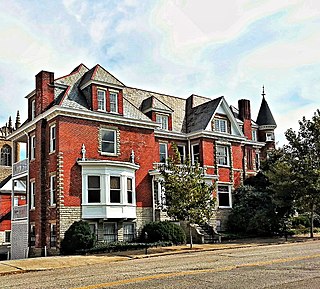
Campbell–Hicks House is a historic home located at Huntington, Cabell County, West Virginia. It was built in 1896, and is a 2+1⁄2-story, masonry dwelling in the Queen Anne style. It features a slender, two story cantilevered rounded tower. It also has a full front porch with a roof upheld by five sets of paired fluted columns with Ionic order capitals.

The Thomas Carroll House, also known as the Madie Carroll House, is an historic home located in the Guyandotte neighborhood in the city of Huntington, Cabell County, West Virginia. It is also known as one of the oldest structures in Cabell County. The original section of the house was built prior to 1810, and is believed to have arrived in Guyandotte by flatboat from Gallipolis, Ohio. The property was purchased by Thomas Carroll in March 1855 and remained under the ownership of his descendants until it was deeded to the Greater Huntington Parks and Recreation District on October 10, 1984, after the last tenant, Miss Madie Carroll's demise. It is one of the few houses in Guyandotte to survive the Civil War and even once was a church, an inn, and a home to many. During the Civil War the house was a safe haven for Union soldiers which is a rich history that the Madie Carroll House Preservation Society has spent the last few decades protecting and educating many on. As of today the house is owned and operated by the Madie Carroll House Preservation Society where they hold several events such as their annual Guyandotte Civil War Days. It is open to the public as a museum. It was listed on the National Register of Historic Places in 1973.
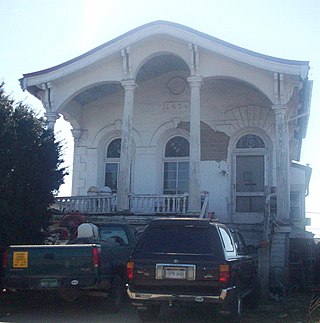
Harvey House, also known as the "Coin" Harvey House, is a historic home located at Huntington, Cabell County, West Virginia. It was built in 1874, and is a two-story dwelling reminiscent of houses in New Orleans. It features stained glass windows, a cast iron mantel, and a beamed ceiling in the dining room. It is most notable as the home of William Hope "Coin" Harvey.

Johnston-Meek House is a historic home located at Huntington, Cabell County, West Virginia. It is a two-story, brick Colonial Revival style dwelling with a hipped roof. The original section was built in 1832, with additions in 1838, 1923, and 1941. The 1923 Colonial Revival entrance portico and a number of other significant modifications were designed by local architect Sidney L. Day.
Kenwood, also known as the John A. Sheppard House, is a historic home located at Huntington, Cabell County, West Virginia. It was designed by the prominent West Virginia architect, H. Rus Warne, and built about 1910, and is a 2+1⁄2-story, rectangular, side gable house with flanking one-story, enclosed wings with flat roofs covered in green clay tile. The house measures approximately 100 feet long and 64 feet deep. It features an entrance portico with two story Tuscan order columns. The house is in the Classical Revival style with Greek Revival details. Also on the property is a contributing garage.
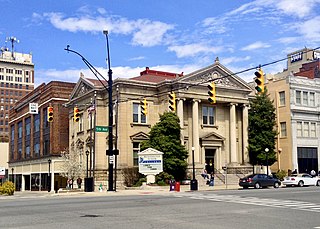
The Carnegie Public Library at Huntington, West Virginia, formerly also known as the Cabell County Public Library, is a historic library building located on the northeast corner of Fifth Avenue and Ninth Street. It was the first public library in the county. It served the community as a library until 1980, when a new library opened across the street. The building currently houses the Huntington Junior College.

The Memorial Arch is a historic memorial arch located in Memorial Park at Huntington, Cabell County, West Virginia. It was built between 1924 and 1929 by the Cabell County War Memorial Association as a memorial to the dead and to those who served the county in World War I. It is built of gray Indiana limestone on a gray granite base. It measures 42 feet high, 34 feet wide, and 9 feet deep. It features Classical Revival style bas-relief carvings. The structure was rededicated in 1980. It is the only triumphal style arch in West Virginia.

The West Virginia Colored Children's Home was a historic school, orphanage, and sanatorium building located near Huntington, Cabell County, West Virginia. It was the state's first social institution exclusively serving the needs of African American residents. The main structure, built in 1922–1923, was a three-story red brick building in the Classical Revival style. That building, located at 3353 U.S. Route 60, Huntington, West Virginia, was the last of a series of buildings that were constructed on the site. It was also known as the West Virginia Colored Orphans Home, Colored Orphan Home and Industrial School, the West Virginia Home for Aged and Infirm Colored Men and Women, and University Heights Apartments. It was listed on the National Register of Historic Places in 1997 but was demolished in 2011.
Freeman Estate, also known as Park Hill Farm, is a historic home located at Huntington, Cabell County, West Virginia. The estate house was built between 1912 and 1914 and is a 2+1⁄2-story, masonry American Craftsman-style dwelling. It measures 11,000-square-foot (1,000 m2) and has a red, clay-tile roof.

Downtown Huntington Historic District is a national historic district located at Huntington, Cabell County, West Virginia. The original district encompassed 59 contributing buildings; the boundary increase added 53 more contributing buildings. It includes the central business district of Huntington and includes several of its municipal and governmental buildings. It contains the majority of the historic concentration of downtown commercial buildings. Located in the district are the separately listed Carnegie Public Library, Cabell County Courthouse, U.S. Post Office and Court House, and Campbell-Hicks House.
Hawthorne Historic District is a national historic district located at Huntington, Cabell County, West Virginia. The district encompasses 24 contributing buildings and 1 contributing structure in the Park Hills Subdivision No. 1. The district is composed entirely of early 20th century residences, the majority of which are Colonial Revival style.
